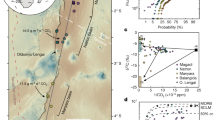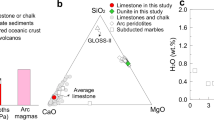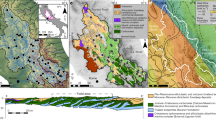Abstract
The continental lithosphere is a vast store for carbon. The carbon has been added and reactivated by episodic freezing and re-melting throughout geological history. Carbon remobilization can lead to significant variations in CO2 outgassing and release in the form of magmas from the continental lithosphere over geological timescales. Here we use calculations of continental lithospheric carbon storage, enrichment and remobilization to demonstrate that the role for continental lithosphere and rifts in Earth’s deep carbon budget has been severely underestimated. We estimate that cratonic lithosphere, which formed 2 to 3 billion years ago, originally contained about 0.25 Mt C km–3. A further 14 to 28 Mt C km–3 is added over time from the convecting mantle and about 43 Mt C km–3 is added by plume activity. Re-melting focuses carbon beneath rifts, creating zones with about 150 to 240 Mt C km–3, explaining the well-known association of carbonate-rich magmatic rocks with rifts. Reactivation of these zones can release 28 to 34 Mt of carbon per year for the 40 million year lifetime of a continental rift. During past episodes of supercontinent breakup, the greater abundance of continental rifts could have led to short-term carbon release of at least 142 to 170 Mt of carbon per year, and may have contributed to the high atmospheric CO2 at several times in Earth's history.
This is a preview of subscription content, access via your institution
Access options
Access Nature and 54 other Nature Portfolio journals
Get Nature+, our best-value online-access subscription
$29.99 / 30 days
cancel any time
Subscribe to this journal
Receive 12 print issues and online access
$259.00 per year
only $21.58 per issue
Buy this article
- Purchase on Springer Link
- Instant access to full article PDF
Prices may be subject to local taxes which are calculated during checkout




Similar content being viewed by others
References
Dasgupta, R. & Hirschmann, M. M. The deep carbon cycle and melting in Earth’s interior. Earth Planet. Sci. Lett. 298, 1–13 (2010).
Dasgupta, R. Ingassing, storage, and outgassing of terrestrial carbon through geologic time. Rev. Mineral. Geochem. 75, 183–229 (2013).
Kelemen, P. B. & Manning, C. R. Reevaluating carbon fluxes in subduction zones, what goes down, mostly comes up. Proc. Natl Acad. Sci. USA 112, E3997–E4006 (2015).
Kagoshima, T. et al. Sulfur geodynamic cycle. Sci. Rep 5, 8330 (2015).
Lee, H. et al. Massive and prolonged deep carbon emissions associated with continental rifting. Nat. Geosci. 9, 145–149 (2016).
Caracausi, A., Patermoster, M. & Nuccio, P. M. Mantle CO2 degassing at Mt. Vulture volcano (Italy): relationship between CO2 outgassing of volcanoes and the time of their last eruption. Earth Planet. Sci. Lett. 411, 268–280 (2015).
Chiodini, G. et al. Carbon dioxide Earth degassing and seismogenesis in central and southern Italy. Geophys Res. Lett. 31, L07615 (2004).
Lewicki, J. L. & Brantley, S. L. CO2 degassing along the San Andreas fault, Parkfield, California. Geophys. Res. Lett. 27, 5–8 (2000).
Inguaggiato, C., Censi, P., D’Alessandro, W. & Zuddas, P. Geochemical characterization of gases along the Dead Sea rift: evidences of mantle-CO2 degassing. J. Volc. Geotherm. Res 320, 50–57 (2016).
Mutlu, H., Güleç, N. & Hilton, D. R. Helium–carbon relationships in geothermal fluids of western Anatolia, Turkey. Chem. Geol. 247, 305–321 (2008).
Angelier, J., Bergerat, F., Dauteull, O. & Villemin, T. Effective tension–shear relationships in extensional fissures swarms, axial rift zone of northeastern Iceland. J. Struct. Geol. 19, 673–685 (1997).
Ebinger, C. & Scholz, C. A. C in Tectonics of Sedmimentary Basins: Recent Advances (Bubsy, C. & Perez, A. A.) 185–208 (Wiley-Blackwell, Chichester, 2012)
Burton, M. R., Sawyer, G. M. & Granieri, D. Deep carbon emissions from volcanoes. Rev. Mineral. Geochem. 75, 323–354 (2013).
Hutchison, W. et al. Causes of unrest at silicic calderas in the East African Rift: new constraints from InSAR and soil-gas chemistry at Aluto volcano, Ethiopia. Geochem. Geophys. Geosyst. 17, 3008–3030 (2016).
Robertson, E. et al. Diffuse degassing at Longonot volcao, Kenya: implications for CO2 flux in continental rifts. J. Volc. Geotherm. Res. 327, 208–222 (2016)
Woolley, A. R. in Carbonatites: Genesis and Evolution (ed. Bell, K.) 15–37 (Unwin-Hyman, London, 1989).
Foley, S. F., Link, K., Tiberindwa, J. V. & Barifaijo, E. Patterns and origin of igneous activity around the Tanzanian craton. J. Afr. Earth Sci. 62, 1–18 (2012).
Fischer, T. P. et al. Upper-mantle volatile chemistry at Oldoinyo Lengai volcano and the origin of carbonatites. Nature 459, 77–80 (2009).
Kjarsgaard, B. A. & Peterson, T. Nephelinite–carbonatite immiscibility at Shombole volcano, East Africa — petrographic and experimental evidence. Mineral. Petrol. 43, 293–314 (1991).
Gudfinnsson, G. H. & Presnall, D. C. Continuous gradations among primary carbonatitic, kimberlitic, melilititic, basaltic, picritic and komatiitic melts in equilibrium with garnet lherzolite at 3–8 GPa. J. Petrol. 46, 1645–1659 (2005).
Foley, S. F. et al. The composition of near-solidus melts of peridotite in the presence of CO2 and H2O at 40–60 kbar. Lithos 112S, 274–283 (2009).
Woolley, A. R. & Kjarsagaard, B. A. Carbonatite occurrences of the world: map and database. J. Petrol. 50, 195–196 (2008).
Tappe, S. et al. Craton reactivation on the Labrador Sea mergins: 40Ar/39Ar age and Sr–Nd–Hf–Pb isotope constraints from alkaline and carbonatite intrusives. Earth Planet. Sci. Lett. 256, 433–456 (2007).
Larsen, L. M., Rex, D. C. & Secher, K. The age of carbonatites, kimberlites and lamprophyres from southern West Greenland: recurrent alkaline magmatism during 2500 million years. Lithos 16, 215–221 (1983).
Boyd, F. R. & Gurney, J. J. Diamonds and the African lithosphere. Science 272, 472–477 (1986).
Williams, L. A. J. in Continental and Oceanic Rifts (ed Pàlmason, G.) 193–222 (American Geophysical Union, 1978).
Rogers, N. W., James, D., Kelley, S. P. & de Mulder, M. The generation of potassic lavas from the eastern Virunga province, Rwanda. J. Petrol. 39, 1223–1247 (1998).
Tappe, S. et al. Genesis of ultramafic lamprophyres and carbonatites at Aillik Bay, Labrador: a consequence of incipient lithospheric thinning beneath the North Atlantic craton. J. Petrol. 47, 1261–1315 (2006).
Rosenthal, A., Foley, S. F., Pearson, D. G., Nowell, G. M. & Tappe, S. Magmatic evolution at the propagating tip of a continental rift — a geochemical study of primitive alkaline volcanic rocks of the western branch of the East African Rift. Earth Planet. Sci. Lett. 284, 236–248 (2009).
Foley, S. F. Rejuvenation and erosion of the cratonic lithosphere. Nat. Geosci. 1, 503–510 (2008).
Lee, C.-T. A. Geochemical/petrologic constraints on the origin of cratonic mantle. Geophys. Monog. Ser. 164, 89–114 (2006).
Sleep, N. H. Stagnant lid convection and carbonate metasomatism of the deep continental lithosphere. Geochem. Geophy. Geosyst. 10, Q11010 (2009).
Sobolev, S. et al. Linking mantle plumes, large igneous provinces and environmental catastrophes. Nature 477, 312–316 (2011).
Dasgupta, D., Hirschmann, M. M. & Withers, A. C. Deep global recycling of carbon constrained by the solidus of anhydrous carbonated eclogite under upper mantle conditions. Earth Planet. Sci. Lett. 227, 73–85 (2004).
Navon, O. Diamond formation in the Earth’s mantle. Proc. 7th Int. Kimberlite Conf. (Red Roof Design, Cape Town, 1999).
Foley, S. F. A review and assessment of experiments on kimberlites, lamproites and lamprophyres as a guide to their origin. Proc. Indian Acad. Sci. 99, 57–80 (1990).
Konzett, J., Armstrong, R. A. & Gunther, D. Mantle metasomatism in the Kaapvaal craton lithosphere: constraints on timing and genesis from U–Pb zircon dating of metasomatized peridotites and MARID-type xenoliths. Contrib. Mineral. Petrol. 139, 704–719 (2000).
Foley, S. F. A reappraisal of redox melting in the Earth’s mantle as a function of tectonic setting and time. J. Petrol. 52, 1363–1391 (2011).
Rohrbach, A. & Schmidt, M. W. Redox freezing and melting in the Earth’s deep mantle resulting from carbon–iron redox coupling. Nature 472, 209–212 (2011).
Griffin, W. L., O’Reilly, S. Y., Afonso, J. C. & Begg, G. C. The composition and evolution of lithospheric mantle: a re-evaluation and its tectonic implications. J. Petrol. 50, 1185–1204 (2009).
Woodland, A. B., Kornprobst, J., McPherson, E., Bodinier, J. L. & Menzies, M. A. Metasomatic interactions in the lithospheric mantle: petrologic evidence from the Lherz massif, French Pyrenees. Chem. Geol. 134, 83–112 (1996).
Yaxley, G. M., Berry, A. J., Rosenthal, A., Woodland, A. B. & Paterson, D. Redox preconditioning deep cratonic lithosphere for kimberlite genesis — evidence from the central Slave Craton. Sci. Rep. 7, 30 (2017).
Francis, D. & Patterson, M. Kimberlites and aillikites as probes of the continental lithopsheric mantle. Lithos 109, 72–80 (2009).
Elkins-Tanton, L. T. & Hager, B. H. Melt intrusion as a trigger for lithospheric foundering and the eruption of Siberian flood basalts. Geophys. Res. Lett. 27, 3937–3940 (2000).
Svensen, H. et al. Hydrothermal venting of greenhouse gases triggering Early Jurassic global warming. Earth Planet. Sci. Lett. 256, 554–566 (2007).
Ganino, C. & Arndt, N. T. Climate changes caused by degassing of sediments during the emplacement of large igneous provinces. Geology 37, 323–326 (2009).
Svensen, H. et al. Siberian gas venting and the end-Permian environmental crisis. Earth Planet. Sci. Lett. 277, 490–500 (2009).
Brune, S., Williams, S. E. & Müller, R. D. Potential links between continental rifting, CO2 degassing and climate change through time. Nat. Geosci. http://doi.org/10.1038/s41561-017-0003-6 (2017).
Li, M. et al. Quantifying melt production and degassing rate at mid-ocean ridges from global mantle convection models with plate motion history. Geochem. Geophys. Geosyst. 17, 2884–2904 (2016).
Eby, G., Lloyd, F. E. & Woolley, A. R. Geochemistry and petrogenesis of the Fort Portal, Uganda, extrusive carbonatite. Lithos 113, 785–800 (2009).
Self, S., Widdowson, M., Thordarson, T. & Jay, A. E. Volatile fluxes during flood basalt eruptions and potential effects on the global environment: a Deccan perspective. Earth Planet. Sci. Lett. 248, 518–532 (2006).
Hawkesworth, C. J. & Kemp, A. I. S. Evolution of the continental crust. Nature 443, 811–817 (2006).
Artemieva, I. M. & Mooney, W. D. Thermal thickness and evolution of Precambrian lithosphere: a global study. J. Geophys. Res. 106, 16387–16414 (2001).
Jaupart, C. & Mareschal, J. C. The thermal structure and thickness of continental roots. Lithos 48, 93–114 (1999).
Köhler, T. & Brey, G. P. Geothermobarometry in 4-phase lherzolites. 2. New thermobarometers, and practical assessment of existing thermobarometers. J. Petrol. 31, 1353–1378 (1990).
Cogley, J. G. Continental margins and the extent and number of the continents. Rev. Geophys. 22, 101–122 (1984).
Pearson, D. G. The age of continental roots. Lithos 48, 171–194 (1999).
Rollinson, H. R. Early Earth Systems: A Geochemical Approach (Wiley, London, 2007).
Jacob, D. E. Nature and origin of eclogite xenoliths from kimberlites. Lithos 77, 295–316 (2004).
Shirey, S. B. & Richardson, S. H. Start of the Wilson Cycle at 3 Ga shown by diamonds from subcontinental mantle. Science 333, 434–436 (2011).
Ireland, T. R., Rudnick, R. L. & Spetius, Z. Trace-elements in diamond inclusions from eclogites reveal link to Archean granites. Earth Planet. Sci. Lett. 128, 199–213 (1994).
Yaxley, G. M. & Green, D. H. Experimental demonstration of refractory carbonate-bearing eclogite and siliceous melt in the subduction regime. Earth Planet. Sci. Lett. 128, 313–325 (1994).
Tsuno, K. & Dasgupta, R. The effect of carbonates on near-solidus melting of pelite at 3 GPa: relative efficiency of H2O and CO2 subduction. Earth Planet. Sci. Lett. 319–320, 185–196 (2012).
Van Hunen, J. & Moyen, J.-F. Archean subduction: fact or fiction? Ann. Rev. Earth Planet. Sci. 40, 195–219 (2012).
Hargraves, R. B. Faster spreading or greater ridge length in the Archean? Geology 14, 750–752 (1986).
Marschall, H. R. & Schumacher, J. C. Arc magmas sourced in melange diapirs in subduction zones. Nat. Geosci. 5, 862–867 (2012).
Chen, C. et al. Paleo-Asian oceanic slab under the North China craton revealed by carbonatites derived from subducted limestones. Geology 44, 1039–1042 (2016).
Saal, A. E., Hauri, E. H., Langmuir, C. H. & Perfit, M. R. Vapour undersaturation in primitive mid-ocean ridge basalt and the volatile content of Earth’s upper mantle. Nature 419, 451–455 (2002).
Cartigny, P., Pineau, F., Aubaud, C. & Javoy, M. Towards a consistent mantle carbon flux estimate: insights from volatile systematics (H2O/Ce, δD, CO2/Nb) in the North Atlantic mantle (14 °N and 34 °N). Earth Planet. Sci. Lett. 265, 672–685 (2008).
Hirschmann, M. M. & Dasgupta, R. The H/C ratios of earth’s near-surface and deep reservoirs, and consequences for deep Earth volatile cycles. Chem. Geol. 262, 4–16 (2009).
Dasgupta, R. & Hirschmann, M. M. Melting in the Earth’s deep upper mantle caused by carbon dioxide. Nature 440, 659–662 (2006).
McKenzie, D. The extraction of magma from the crust and mantle. Earth Planet. Sci. Lett. 74, 81–91 (1985).
Sleep, N. H. Tapping of melts by veins and dykes. J. Geophys. Res 93, 10255–10272 (1988).
Foley, S. Vein-plus-wall-rock melting mechanisms in the lithosphere and the origin of potassic alkaline magmas. Lithos 28, 435–453 (1992).
Kessel, R., Schmidt, M. W., Ulmer, P. & Pettke, T. Trace element signature of subduction zone fluids, melts and supercritical liquids at 120–180 km depth. Nature 437, 724–727 (2005).
Genge, M. J., Price, G. D. & Jones, A. P. Molecular dynamics simulations of CaCO3 melts to mantle pressures and temperatures: implications for carbonatite magmas. Earth Planet. Sci. Lett. 131, 225–238 (1995).
Dawson, J. B. in Mantle Xenoliths (ed. Nixon, P. H.) 465–473 (John Wiley & Sons, New York, 1987).
Harte, B., Winterburn, P. & Gurney, J. J. in Mantle Metasomatism (ed. Menzies, M. & Hawkesworth, C. J.) 145–220 (Academic, London, 1987).
Acknowledgements
The concept for this paper was born in the coffee break of a Deep Carbon Observatory Workshop in Berkeley, led by T. Plank and R. Dasgupta, to which both authors were invited and sponsored participants. D. Jacob provided critical comments and S.-A. Hodgekiss improved the figures. This is contribution 995 from the ARC Centre of Excellence for Core to Crust Fluid Systems and 1170 in the GEMOC Key Centre. T.F. acknowledges support from NSF (EAR-11130660) for this work.
Author information
Authors and Affiliations
Contributions
S.F. planned the manuscript with input from T.F. The paper combines the complementary expertise of both authors.
Corresponding author
Ethics declarations
Competing interests
The authors declare no competing financial interests.
Additional information
Publisher’s note: Springer Nature remains neutral with regard to jurisdictional claims in published maps and institutional affiliations.
Rights and permissions
About this article
Cite this article
Foley, S.F., Fischer, T.P. An essential role for continental rifts and lithosphere in the deep carbon cycle. Nature Geosci 10, 897–902 (2017). https://doi.org/10.1038/s41561-017-0002-7
Received:
Accepted:
Published:
Issue Date:
DOI: https://doi.org/10.1038/s41561-017-0002-7
This article is cited by
-
Origin and tectonic setting of low-Si alkaline magma
Science China Earth Sciences (2024)
-
Carbonate-rich crust subduction drives the deep carbon and chlorine cycles
Nature (2023)
-
Geodynamics of continental rift initiation and evolution
Nature Reviews Earth & Environment (2023)
-
Imperfections in natural diamond: the key to understanding diamond genesis and the mantle
La Rivista del Nuovo Cimento (2023)
-
Plate Tectonics: The Stabilizer of Earth’s Habitability
Journal of Earth Science (2023)



